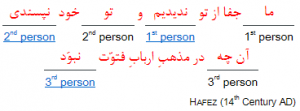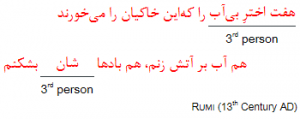The person grammatical category of a noun phrase indicates whether the speaker or the addressees are members of the set represented by the noun phrase.
| Contents |
|---|
a. Person’s Subcategories
The following subcategories of the person are relevant in Persian, similarly to most of other languages:
a•a. First Person
Noun phrases which are used in the 1st person represent a set, of which the speaker is an element. Such a noun phrase can be in the singular or the plural form, and is always definite.
Persian noun phrases are used in the 1st person only in these cases:
- The personal pronoun /mæn/ من:
من ترکِ عشقِ شاهد و ساغر نمیکنم
سد بار توبه کردم و دیگر نمیکنم
Hafez (14th Century AD)
- The personal pronouns /mɒ/ ما, /æmɒ/ اما, /hæmɒ/ هما, /imɒ/ ایما, /mɒhɒ/ ماها and /mɒjɒn/ مایان:
سالها دفعِ بلاها کردهایم
وهم حیران زآن چه ماها کردهایم
Rumi (13th Century AD)
- The possessive pronouns /-m/ and /-mɒn/:
رفتم، که مباد بی تو خوش یک نفسم /næfæs-æm/
وز گردشِ روزگار این داغ بسم /bæs-æm/
Azraqi Herati (11th Century AD)
- Nominal Determiner phrases with the determinativized personal pronoun /mæn/ من. Only two of them are known from the Persian literature: /mæn bændæ/ منبنده and /mæn ræhi/ منرهی:
منّت خدای را! که به تیرِ خدایگان
من بنده بیگنه نشدم کشته رایگان
Mu’izzi (11th and 12th Century AD)
من رهی تا بِزیَم مدح و ثنایِ تو کنم
شرف آن را بفزاید که ثنایِ تو کند
Manuchehri (10th and 11th Century AD)
In modern idioms, only the short form /bændæ/ بنده exists:
مثالِ بنده و تو ای نگارِ دلبرِ من
به قرصِ شمس و به وَرتاج سخت میماند
Aghadji (10th Century AD)
- Qualitative genitive phrases with nuclei in the 1st person singular (see 7•۱•b.):
آسمان بارِ امانت نتوانست کشید
قرعهیِ کار به نامِ منِ دیوانه زدند
Hafez (14th Century AD)
In Persian, this constellation does not appear in the 1st person plural.
- The nominal determiner phrases /in ʤɒneb/ این جانب and /in ʤɒnebɒn/ این جانبان (see 7•۶•a.). These phrases are used since the Qajar era, and predominently in the officials of Iran.
- Coordinations, if at least one of their elements is used in the 1st person:
اگر غم لشکر انگیزد که خونِ عاشقان ریزد
من و ساقی به هم سازیم و بنیادش بر اندازیم
Hafez (14th Century AD)
- Every partitive genitive phrase is in the 1st person plural, if its modifier is also in the 1st person plural and the speaker is an element of the subset represented by the nucleus (see 10•۴•d•a.):
تکتکِ ما با او بدرود گفتیم.
نیمی از ما در تهران به سر میبریم.
-
The following pronouns can be in every person, including the 1st person:
- Reflexive and intensive pronouns (see 7•۳•a.):
از در در آمدیّ و من از خود به در شدم
گویی کهاز این جهان به جهانِ دگر شدم
Saadi (12th and 13th Century AD)
- Reciprocal pronouns (see 7•۵.):
به غمخواریِ یکدگر غم خوریم
به شادی همان یارِ یکدیگریم
Nezami Gandjavi (12th and 13th Century AD)
- Associative pronouns (see 7•۹•b.):
بتپرستی گرفتهایم همه
این جهان چون بتست و ما شَمَنیم
Rudaki (9th and 10th Century AD)
- Reflexive and intensive pronouns (see 7•۳•a.):
a•b. Second Person
Noun phrases in the 2nd person refer to a set, of which the speaker is not an element, but the addressee. Such a noun phrase can be in the singular or the plural form, and is always definite.
Persian noun phrases are used in the 2nd person only in these cases:
- The personal pronoun /to/ تو:
تو آن گه دانشی باشی که دانی
که از دریایِ جهلت نیست معبر
Nasir Khusraw (11th Century AD)
- The personal pronouns /ʃomɒ/ شما, /ʃomɒhɒ/ شماها and /ʃomɒjɒn/ شمایان:
شمایان را از این اخبار تفصیلی دادم.
Abolfazl Beyhaqi (10th and 11th Century AD)
- The possessive pronouns /-t/ and /-tɒn/:
اگر تا شهر به همان حـال میآوردندت /mi-ɒværdænd-æt/، چه میکردی؟!
Jalal Al-e Ahmad (20th Century AD)
- Qualitative genitive phrases with nuclei in the 2nd person singular (see 7•۱•b.):
تا تویِ لببسته گشادی نفس
یک سخنِ نغز نگفتی به کس
Nezami Gandjavi (12th and 13th Century AD)
In Persian, this constellation does not appear in the 2nd person plural.
- The Qualitative genitive phrases /ʤenɒb-e ɒli/ جنابِ عالی and /hæzræt-e ɒli/ حضرتِ عالی. These phrases have been used since the Qajar era and mostly in the officials of Iran.
- Coordinations, if no element of them is used in the 1st person, but at least one of their elements is in the 2nd person:
تو و خواهرت امروز این جا میمانید.
- Every partitive genitive phrase is in the 2nd person plural, if its modifier is also in the 2nd person plural and the addressee is an element of the subset represented by the nucleus (see 10•۴•d•a.):
همهیِ شما او را میشناسید.
چند نفرتان زیرِ ۱۸ سال هستید.
-
The following pronouns can be in every person, including the 2nd person:
- Reflexive and intensive pronouns (see 7•۳•a.):
بازیِ خود دیدی، ای شترنجباز!
بازیِ خصمت ببین پهن و دراز
Rumi (13th Century AD)
- Reciprocal pronouns (see 7•۵.):
شما با همدیگر سرِ سازش ندارید.
- Associative pronouns (see 7•۹•b.):
همگان حـالِ من شنیدهستید
بلکه دانستهاید و دیده عیان
Farrukhi Sistani (10th and 11th Century AD)
- Reflexive and intensive pronouns (see 7•۳•a.):
a•c. Third Person
A noun phrase in the 3rd person refers to a set in which neither the speaker nor the addressee are elements. Such a noun phrase can be in any number or Definiteness subcategory.
b. Concord and Discord in the Person
(See 3•۱•b. Concord and Discord in the Number and 3•۴•b. Concord and Discord in the Polarity.)
The concord in the person in Persian has the following aspects:
-
Verbal concord: The subject (a noun phrase) and the predicate (a verb phrase) are in a sentence in the same person subcategory:
-
Pronominal concord: The noun phrase and the pronoun which substitutes it are in the same person subcategory:
-
Dislocational concord: The dislocated constituent is in the same person subcategory as its placeholder:
As previoulsy discussed in Chapter “discord in the number”, the following pronouns appear in the 3rd person singular in Persian, while the predicate conforms to the number and the person of the superset, and can cause a verbal discord:
- Distributive pronouns (see 7•۸•b•a.):
هر یک از راهِ دیگری برایِ سرافرازیِ کشور تلاش میکنیم.
هر کدامتان داستانی دیگر برایم تعریف میکنید.
- Inexistential pronouns (see 7•۱۰•b.):
هیچ یک پاسخی به این پرسش نداشتیم.
هیچ کدام دچارِ بیخوابی نیستید.
- Selective pronouns (see 7•۱۱.):
باید یک کدام این خبر را به او بدهیم.
یک کدامتان او را لو دادهاید.
However, the predicate becomes concordant (in the 3rd person singular) if the superset attributes the pronoun as an origative adverbial:
باید یک کدام از ما این خبر را به او بدهد.
از شماها یک کدام او را لو داده است.
هر یک از ما ایرانیان از راهِ دیگری برایِ سرافرازیِ کشور تلاش میکند.
هر کدام از شما داستانی دیگر برایم تعریف میکند.
هیچ یک از ما فرزندان پاسخی به این پرسش نداشت.
هیچ کدام از شما دختران دچارِ بیخوابی نیست.




